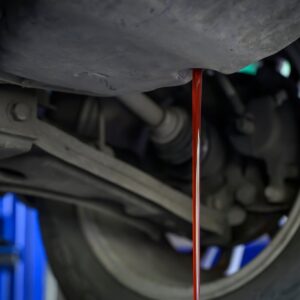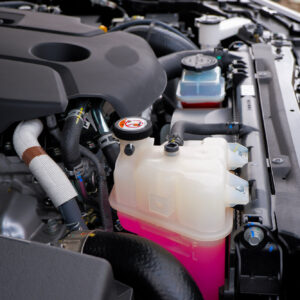If you’ve ever tried fitting an automatic vehicle’s radiator on a manual car, then you probably noticed outlets on the radiator that don’t connect to any lines on your manual vehicle. This is because these ports actually connect to transmission cooler lines, which are typically only found in automatic transmissions.
What Is a Transmission Cooler Line?
Also known as the transmission cooling line, the transmission cooler line connects the transmission cooler to the radiator, where hot transmission fluid cools down before flowing back to the gearbox.
The transmission cooler, when it is part of the radiator (some transmission coolers are external), is a small heat exchanger mounted inside the side of the radiator where the coolant has already given up its heat to the air passing through the radiator and is making its exit from the radiator flues so it can adequately cool the transmission fluid.
Most transmission cooler lines are steel and connected to the cooler ports with flare nuts, but some have short rubber oil resistant hoses connecting the steel lines to the transmission cooler ports. The cooler ports are sealed where they pass through the radiator end tank to prevent coolant from leaking around the port.
How Do Transmission Cooling Lines Work?
Automatic transmissions generate a lot of heat, which is created in the torque converter where the impeller and the turbine interact. The cooler line that carries fluid to the transmission cooler carries fluid that is departing from the pressurized torque converter to the heat exchanger in the radiator (or the external transmission cooler, if so equipped). The cooler line returning the fluid to the transmission delivers it to the sump to be filtered before being drawn back into the pump.
Do All Vehicles Have Transmission Cooler Lines?
Not all vehicles have transmission cooler lines because not all vehicles actually need them. Manual transmissions don’t have torque converters, which is the primary heat source in automatic transmissions. This means they don’t generate as much heat as automatic transmissions do, eliminating the need for a transmission cooler in the first place.
Can You Use an Automatic Car’s Radiator on a Manual Vehicle?
Ideally, you should always get a radiator that’s specifically designed for your vehicle. However, we know it isn’t always easy to get your hands on one. Luckily, some owners have found a solution to this dilemma. They installed an automatic vehicle’s radiator on their manual vehicles instead.
As long as the radiator was in good condition and compatible with their car, they didn’t seem to run into any issues. They didn’t have to install a transmission cooling line either. Some simply left the plugs that came with the packaging to prevent any debris from entering through the transmission line’s ports on the radiator.
Symptoms of a Faulty Transmission Cooler Line
It’s important to know when your transmission cooler lines might need to be replaced. The most common reason would be that the line is leaking, and this would be easy to see.
Unpleasant Burning Smell
If you start smelling a foul burning odor, chances are it’s because of a damaged transmission cooling line. When transmission fluid leaks from a damaged cooling line, it can come into contact with hot engine components and produce an unpleasant burnt smell.
If the line is leaking enough to cause a burning smell, you’ll usually see transmission fluid stains where you park.
Overheating Transmission
Pinched or clogged transmission cooling lines won’t be able to transport fluid between the transmission and radiator, causing the transmission to overheat.
Illuminated Check Engine Light
If the transmission is overheating so that the TCM/PCM detects incorrect gear ratios or slipping, the check engine light or malfunction indicator light (MIL) may be illuminated, but on some systems, a transmission code may be stored without illuminating the MIL. Some systems have a separate warning light for the transmission that looks like a gear, or they may flash the “overdrive indicator” light when a transmission gear ratio or slipping concern is detected.
Transmission Fluid Leaks
If you notice a red-colored puddle underneath your vehicle, then you’re likely dealing with a transmission fluid leak. This can be caused by cracked transmission cooler lines that can eventually lead to a low transmission fluid level.
Visible Damage
When inspecting your transmission, be sure to check your transmission cooling lines for proper routing or damage. Transmission lines don’t usually wear and aren’t damaged unless somebody has done work on the vehicle and mis-routed them so that they chafe against other parts while driving. On older transmissions, the lines can crack at the fittings and leak, but the only indicator you have that they’re cracked that way is that they leak around the fitting.
How Much Does a Transmission Cooling Line Cost?
Seeing as how a faulty transmission cooling line can lead to several transmission issues, it’s best to replace it as soon as you know there’s a problem with one. Transmission cooling lines can be replaced with steel or copper tubing, which doesn’t cost that much, and usually this is the best way.
Replace Your Faulty Transmission Line Connector Today
When replacing the transmission cooler line, don’t forget to check on the transmission line connector too. This component helps secure the lines to the transmission and transmission cooler. If it wears or fails alongside the transmission cooler line, your transmission system is likely to overheat and eventually fail. A damaged transmission certainly won’t be cheap to replace, so it’s best to replace the transmission line connector as soon as possible. Luckily, you can easily find a high-quality transmission line connector at CarParts.com.
CarParts.com’s catalog features a wide selection of transmission line connectors for different types of vehicles. For easier browsing, make sure to use our vehicle selector. All you have to do is input your vehicle’s year, make, and model, and you’ll see all the transmission line connectors compatible with your ride. The best part is, you don’t have to wait too long for your order to arrive. If you order by 12 PM ET, you can expect your new transmission line connector to arrive in as fast as two business days.
Don’t wait until your transmission starts overheating before replacing your faulty transmission line connector. Check out our catalog of high-quality transmission line connectors at CarParts.com and get one for your vehicle today!
Any information provided on this Website is for informational purposes only and is not intended to replace consultation with a professional mechanic. The accuracy and timeliness of the information may change from the time of publication.

































